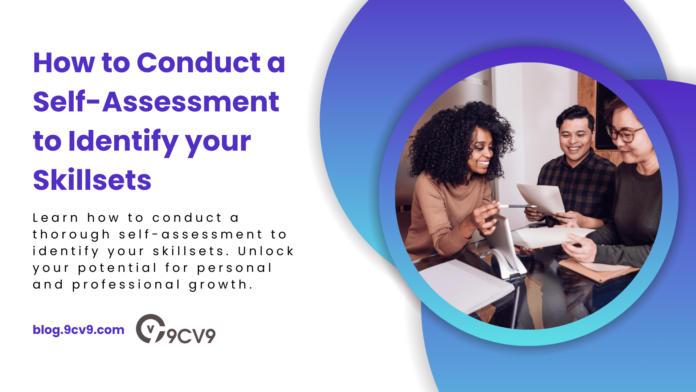Key Takeaways
- Enhance self-awareness: Conducting a self-assessment enables you to gain a deeper understanding of your strengths, weaknesses, and areas for growth, empowering you to make informed decisions.
- Set SMART goals: Utilize the insights gained from self-assessment to set Specific, Measurable, Achievable, Relevant, and Time-bound (SMART) goals, guiding your path towards personal and professional development.
- Leverage technology: Explore online assessments, career assessment platforms, and e-learning resources to streamline the self-assessment process and maximize your skill development potential.
In the fast-paced and ever-evolving landscape of today’s professional world, self-awareness and adaptability have become indispensable assets.
Whether you’re looking to advance in your career, transition to a new field, or simply enhance your personal development journey, understanding your skillsets is paramount.
Welcome to our in-depth exploration: “How to Conduct a Self-Assessment to Identify Your Skillsets.”

Embarking on this journey of self-discovery isn’t just about ticking boxes or listing achievements; it’s a profound dive into the depths of your abilities, passions, and aspirations.
Think of it as a roadmap to unleashing your full potential, tailored specifically to your unique set of talents and strengths.
Why is this topic so crucial?
In a world where job roles are constantly evolving, where industries are being reshaped by technological advancements, and where the global market demands versatility, the ability to recognize and leverage your skillsets is a game-changer. It’s the difference between merely surviving and thriving in your chosen path.
But where do you begin?
The process may seem daunting at first, but fear not.
We’re here to guide you step by step through the intricate journey of self-assessment.
By the end of this comprehensive guide, you’ll not only have a clear understanding of your capabilities but also a strategic plan to harness and further develop them.
Before we delve into the nitty-gritty details, let’s pause for a moment to ponder the significance of self-awareness.
Picture a skilled artisan meticulously crafting a masterpiece.
What sets them apart isn’t just their technical prowess but their profound understanding of their craft—their strengths, their weaknesses, their unique style.
Similarly, by gaining insight into our skillsets, we become the architects of our own success stories, empowered to shape our careers and lives with purpose and clarity.
Throughout this journey, we’ll explore various techniques and methodologies to help you uncover the full spectrum of your abilities.
From reflective journaling to seeking feedback from peers and mentors, from conducting SWOT analyses to leveraging cutting-edge technology, we’ll leave no stone unturned in our quest for self-discovery.
But remember, this isn’t a one-size-fits-all endeavor.
Each individual’s journey is as unique as their fingerprint. What works for one person may not necessarily yield the same results for another.
That’s why we’ve crafted this guide to be flexible and adaptable, providing you with a toolkit of strategies to tailor to your specific needs and circumstances.
So, whether you’re a seasoned professional looking to pivot into a new role, a recent graduate navigating the daunting terrain of the job market, or simply someone on a quest for personal growth and fulfillment, this guide is for you.
Together, let’s embark on this transformative journey of self-assessment and unlock the boundless potential that lies within.
Before we venture further into this article, we like to share who we are and what we do.
About 9cv9
9cv9 is a business tech startup based in Singapore and Asia, with a strong presence all over the world.
With over eight years of startup and business experience, and being highly involved in connecting with thousands of companies and startups, the 9cv9 team has listed some important learning points in this overview of How to Conduct a Self-Assessment to Identify Your Skillsets.
If you are looking for a job or an internship, click over to use the 9cv9 Job Portal to find your next top job and internship now.
How to Conduct a Self-Assessment to Identify Your Skillsets
- Understanding the Concept of Self-Assessment
- Preparing for Self-Assessment
- Exploring Different Types of Skillsets
- Self-Reflection Techniques
- Assessing Your Skillsets
- Leveraging Technology for Self-Assessment
- Setting SMART Goals Based on Your Skillsets
- Developing a Personalized Action Plan
1. Understanding the Concept of Self-Assessment
Self-assessment is not just a buzzword; it’s a powerful tool for personal and professional development.
Let’s delve into the depths of this concept to grasp its significance and implications.
Definition and Significance
- Definition: Self-assessment is the process of introspectively evaluating one’s own skills, abilities, strengths, weaknesses, and personal qualities.
- Significance:
- Empowers individuals: By taking ownership of their self-assessment, individuals gain a deeper understanding of themselves, leading to increased self-confidence and autonomy.
- Facilitates growth: Identifying areas for improvement allows individuals to set realistic goals and actively work towards self-improvement.
- Enhances decision-making: Self-assessment equips individuals with insights into their preferences, values, and strengths, enabling them to make informed decisions about their careers, education, and life choices.
Benefits of Conducting a Self-Assessment
- Increased self-awareness: Self-assessment fosters a heightened sense of self-awareness, enabling individuals to recognize their strengths, weaknesses, and areas for growth.
- Alignment with goals: Understanding one’s capabilities and preferences helps align personal and professional goals, leading to greater satisfaction and fulfillment.
- Career advancement: Through self-assessment, individuals can identify skills gaps and take proactive steps to acquire new skills or refine existing ones, enhancing their employability and career prospects.
- Improved relationships: Enhanced self-awareness enables individuals to communicate more effectively, resolve conflicts, and build stronger interpersonal relationships, both in personal and professional settings.
Examples and Illustrations
- Example 1:
- Career Transition: Sarah, a marketing professional, conducts a self-assessment and discovers a passion for graphic design. Armed with this insight, she decides to pursue further education in design and successfully transitions into a new role as a UI/UX designer.
- Example 2:
- Academic Success: James struggles with time management and organization in his studies. Through self-assessment, he identifies these areas as his weaknesses and implements strategies such as creating a study schedule and utilizing productivity tools. As a result, his grades improve significantly.
- Example 3:
- Conflict Resolution: In a team setting, Emma faces challenges in communicating effectively with her colleagues. Through self-assessment, she realizes that her assertiveness style may come off as aggressive. Armed with this insight, she adopts a more collaborative approach, leading to smoother interactions and improved team dynamics.

Key Takeaways
- Self-assessment is a dynamic and ongoing process that requires introspection, honesty, and a willingness to embrace change.
- Embracing self-assessment empowers individuals to take control of their personal and professional development, leading to greater satisfaction and success.
- By understanding the concept of self-assessment and its significance, individuals can harness its transformative potential to unlock new opportunities and achieve their goals.
2. Preparing for Self-Assessment
Preparation is key to conducting a successful self-assessment.
This section will delve into the essential steps and strategies to ensure you’re ready to embark on this transformative journey of self-discovery.
Setting Clear Goals and Objectives
- Define your purpose: Clearly articulate why you’re conducting a self-assessment. Are you seeking career advancement, personal growth, or clarity on your skills and interests?
- Establish SMART goals: Ensure your goals are Specific, Measurable, Achievable, Relevant, and Time-bound. For example, instead of setting a vague goal like “improve communication skills,” aim for “attend a public speaking workshop and deliver a presentation within three months.”
Creating a Conducive Environment for Self-Reflection
- Find a quiet space: Choose a comfortable and distraction-free environment where you can reflect introspectively without interruptions.
- Set aside dedicated time: Block out time in your schedule specifically for self-assessment. Treat it as you would any other important task or appointment.
- Eliminate distractions: Minimize distractions such as phone notifications, emails, or social media to foster deep focus and concentration.
Gathering Necessary Tools and Resources
- Journal or notebook: Keep a journal or notebook handy to jot down thoughts, insights, and reflections throughout the self-assessment process.
- Assessment tools: Explore online assessments or tools designed to assess personality traits, strengths, and skills. For example, the Myers-Briggs Type Indicator (MBTI) or StrengthsFinder can provide valuable insights.
Examples and Illustrations
- Example 1:
- Career Advancement: Lisa, a project manager, aspires to advance to a leadership role within her organization. To prepare for her self-assessment, she sets clear goals of identifying her leadership strengths and areas for improvement. She schedules regular reflection sessions during quiet evenings, away from work-related distractions, and utilizes assessment tools such as 360-degree feedback surveys to gather insights from colleagues and supervisors.
- Example 2:
- Personal Development: David, a recent college graduate, is unsure about his career path. He decides to conduct a self-assessment to gain clarity on his interests and strengths. David creates a dedicated space in his room for reflection, away from the hustle and bustle of campus life. Armed with a journal and online personality assessments, he spends evenings exploring different career options and evaluating his skills and preferences.
- Example 3:
- Skill Enhancement: Emily wants to enhance her digital marketing skills to stay competitive in her field. Before diving into self-assessment, she researches various online courses and resources available. Emily sets a SMART goal of completing a digital marketing certification within six months and allocates specific time slots each week for self-study. With a quiet corner of her home designated as her study space, Emily immerses herself in learning and regularly tracks her progress.

Key Takeaways
- Setting clear goals and objectives provides direction and focus for your self-assessment journey.
- Creating a conducive environment fosters deep reflection and concentration, enabling you to gain valuable insights.
- Gathering the necessary tools and resources, such as journals, assessment tools, and online courses, equips you with the support needed to conduct a thorough self-assessment.
- By adequately preparing for self-assessment, you lay the foundation for a transformative and enlightening experience that will shape your personal and professional growth.
3. Exploring Different Types of Skillsets
Understanding the various types of skillsets is crucial for conducting a comprehensive self-assessment.
Let’s delve into the distinctions between hard skills, soft skills, and transferable skills, along with relevant examples to illustrate their significance.
Hard Skills vs. Soft Skills: Definitions and Examples
- Hard skills:
- Definition: Hard skills are specific, teachable abilities that can be quantified and measured. They are typically job-specific and acquired through education, training, or experience.
- Examples:
- Technical skills: Programming languages, graphic design, data analysis.
- Industry-specific knowledge: Legal expertise, medical procedures, financial analysis.
- Certifications and qualifications: Project management certification, CPR training, proficiency in Microsoft Excel.
- Soft skills:
- Definition: Soft skills, also known as interpersonal or people skills, refer to non-technical, interpersonal abilities that facilitate effective communication, collaboration, and relationship-building.
- Examples:
- Communication: Verbal communication, written communication, active listening.
- Leadership: Team management, decision-making, conflict resolution.
- Adaptability: Flexibility, resilience, problem-solving.
Transferable Skills and Their Relevance
- Definition: Transferable skills, also known as portable or universal skills, are abilities that can be applied across various roles, industries, and contexts.
- Examples:
- Communication: Effective communication skills are valuable in virtually any profession, whether you’re a salesperson, teacher, or healthcare professional.
- Time management: The ability to prioritize tasks and manage time efficiently is essential in any role, from administrative assistants to project managers.
- Problem-solving: Employers value individuals who can analyze problems, generate solutions, and make informed decisions, regardless of the industry.
Identifying Skills Specific to Your Profession or Industry
- Research job descriptions: Review job postings and descriptions within your desired field or industry to identify the specific skills and qualifications employers are seeking.
- Networking with professionals: Connect with professionals in your industry through networking events, LinkedIn, or industry-specific forums to gain insights into the key skills and competencies required for success.
- Industry publications and resources: Stay updated on industry trends, best practices, and skill requirements by reading industry publications, attending conferences, and participating in professional development opportunities.
Examples and Illustrations
- Example 1:
- Hard Skills: Sarah, a software engineer, possesses hard skills in programming languages such as Python, Java, and JavaScript. These technical skills enable her to develop innovative software solutions and troubleshoot complex technical issues.
- Example 2:
- Soft Skills: David, a marketing manager, excels in soft skills such as communication and leadership. His ability to articulate marketing strategies, collaborate with cross-functional teams, and inspire his colleagues contributes to the success of marketing campaigns and initiatives.
- Example 3:
- Transferable Skills: Emily, a customer service representative, hones transferable skills such as communication and problem-solving. Although her role primarily involves addressing customer inquiries and resolving issues, her ability to communicate effectively and find creative solutions enables her to excel in various customer-facing roles.
Key Takeaways
- Hard skills are specific, teachable abilities acquired through education, training, or experience, while soft skills are interpersonal abilities that facilitate effective communication and collaboration.
- Transferable skills are portable abilities that can be applied across various roles and industries, enhancing employability and versatility.
- Identifying skills specific to your profession or industry requires research, networking, and staying updated on industry trends and requirements.
- By exploring different types of skillsets and understanding their relevance, individuals can conduct a comprehensive self-assessment to identify their strengths, weaknesses, and areas for development.
4. Self-Reflection Techniques
Self-reflection is the cornerstone of self-assessment, enabling individuals to gain insights into their thoughts, feelings, and experiences.
This section explores various techniques and strategies to facilitate deep introspection and self-discovery.
Journaling Prompts for Self-Exploration
- Daily gratitude journal: Reflect on three things you’re grateful for each day. This practice fosters a positive mindset and encourages appreciation for the blessings in your life.
- Future self-reflection: Imagine yourself five or ten years in the future. What goals have you achieved? What does your ideal life look like? Reflect on the steps you need to take to turn this vision into reality.
- Challenge reflection: Think about a recent challenge or setback you faced. What lessons did you learn from the experience? How can you apply these lessons to future situations?
Conducting a SWOT Analysis (Strengths, Weaknesses, Opportunities, Threats)
- Strengths: Identify your unique strengths and talents. What do you excel at? What sets you apart from others? Consider how you can leverage these strengths to achieve your goals.
- Weaknesses: Acknowledge areas where you can improve. What skills or traits do you struggle with? How can you address these weaknesses and turn them into opportunities for growth?
- Opportunities: Explore potential opportunities for personal and professional development. What new experiences or challenges excite you? How can you seize these opportunities to expand your horizons and reach your full potential?
- Threats: Consider external factors that may hinder your progress. What obstacles or challenges do you anticipate? How can you proactively mitigate these threats and stay resilient in the face of adversity?
Seeking Feedback from Peers, Mentors, or Supervisors
- 360-degree feedback: Solicit feedback from peers, supervisors, and subordinates to gain a comprehensive understanding of your strengths and areas for improvement. This multi-dimensional perspective provides valuable insights and promotes self-awareness.
- Mentorship: Seek guidance and mentorship from individuals who possess the skills or experiences you aspire to. Mentors can offer invaluable advice, support, and feedback to help you navigate your personal and professional journey.
- Performance evaluations: Review past performance evaluations or assessments to identify recurring themes or patterns. What feedback have you received in the past? How can you use this feedback to inform your self-assessment and development goals?
Examples and Illustrations
- Example 1:
- Journaling Prompts: Sarah dedicates ten minutes each evening to journaling. She uses journaling prompts to reflect on her day, express gratitude for positive experiences, and identify areas for improvement. By incorporating daily reflection into her routine, Sarah gains clarity and perspective on her goals and aspirations.
- Example 2:
- SWOT Analysis: David conducts a SWOT analysis to evaluate his readiness for a career transition. He identifies his strengths in project management and communication but recognizes a weakness in technical skills. By acknowledging this gap, David enrolls in an online course to enhance his technical proficiency and capitalize on new opportunities in his desired field.
- Example 3:
- Seeking Feedback: Emily requests feedback from her colleagues during a team meeting. She asks specific questions about her communication style, teamwork, and leadership skills. By actively seeking feedback, Emily demonstrates a commitment to self-improvement and fosters a culture of openness and collaboration within her team.

Key Takeaways
- Self-reflection techniques, such as journaling prompts and SWOT analysis, provide structured frameworks for introspection and self-discovery.
- Seeking feedback from peers, mentors, and supervisors offers valuable perspectives and insights to inform your self-assessment and development goals.
- Incorporating self-reflection into your daily routine fosters self-awareness, personal growth, and continuous improvement.
- By embracing self-reflection techniques, individuals can gain clarity, identify areas for growth, and chart a course towards realizing their full potential.
5. Assessing Your Skillsets
Assessing your skillsets is a critical step in the self-assessment process, enabling you to identify your strengths, weaknesses, and areas for improvement.
This section explores various methodologies and strategies to conduct a thorough assessment of your skills and competencies.
Creating a Skills Inventory Checklist
- List your skills: Start by listing all the skills you possess, both hard and soft, across different areas of your life, including professional, academic, and personal.
- Categorize your skills: Organize your skills into categories based on relevance and proficiency. For example, you may categorize technical skills separately from interpersonal skills or leadership abilities.
- Prioritize your skills: Rank your skills based on their importance and relevance to your goals and objectives. Focus on identifying your top strengths and areas where you excel.
Ranking Skills Based on Proficiency and Relevance
- Self-assessment: Reflect on your level of proficiency in each skill. Rate yourself on a scale from novice to expert based on your knowledge, experience, and performance.
- Solicit feedback: Seek feedback from peers, mentors, or supervisors to validate your self-assessment and gain external perspectives on your skills and competencies.
- Compare against benchmarks: Compare your skills against industry benchmarks or standards to gauge your proficiency level and identify areas for improvement.
Identifying Gaps and Areas for Improvement
- Skill gap analysis: Identify gaps between your current skillset and the skills required to achieve your goals. Consider factors such as emerging trends, technological advancements, and industry demands.
- SWOT analysis: Review your strengths, weaknesses, opportunities, and threats to pinpoint areas where you can enhance your skills and address any limitations or obstacles.
- Feedback loop: Continuously seek feedback and reassess your skills over time to track your progress, adapt to changing circumstances, and refine your development goals.
Examples and Illustrations
- Example 1:
- Skills Inventory Checklist: Sarah creates a skills inventory checklist to assess her marketing skills. She lists her proficiency in areas such as content creation, social media management, and data analysis. By categorizing and prioritizing her skills, Sarah identifies content creation as her top strength and data analysis as an area for improvement.
- Example 2:
- Ranking Skills: David ranks his leadership skills based on feedback from his team members and supervisors. While he considers himself proficient in team management and decision-making, he acknowledges a need to improve his delegation skills. By prioritizing skill development in this area, David aims to become a more effective leader.
- Example 3:
- Identifying Gaps: Emily conducts a SWOT analysis to evaluate her customer service skills. She recognizes her strong communication and problem-solving abilities but identifies a lack of technical knowledge as a potential barrier. Emily enrolls in online courses to enhance her technical skills and bridge the gap, positioning herself for future career opportunities.
Key Takeaways
- Creating a skills inventory checklist enables you to systematically assess your skills and prioritize areas for development.
- Ranking skills based on proficiency and relevance provides a clear understanding of your strengths and areas for improvement.
- Identifying gaps and areas for improvement through techniques such as skill gap analysis and SWOT analysis empowers you to set targeted development goals and enhance your skillset over time.
- By assessing your skillsets regularly and adapting to changing demands and opportunities, you can stay competitive, relevant, and resilient in today’s dynamic job market.
6. Leveraging Technology for Self-Assessment
Technology has revolutionized the way we approach self-assessment, offering a myriad of tools and resources to enhance our understanding of our skills, strengths, and areas for development.
This section explores various ways to leverage technology for self-assessment and personal growth.
Online Assessments and Tools for Skill Evaluation
- Personality assessments: Utilize online tools such as the Myers-Briggs Type Indicator (MBTI) or the DiSC assessment to gain insights into your personality traits, preferences, and behavioral tendencies.
- Skills assessments: Take advantage of online platforms that offer skills assessments tailored to specific industries or professions. These assessments can help you identify your strengths and areas for improvement in areas such as technical skills, communication, or leadership.
- Interest inventories: Explore interest inventories or career aptitude tests to uncover your passions, interests, and potential career paths. These assessments can assist you in aligning your skills and strengths with your career goals and aspirations.
Using Career Assessment Platforms
- LinkedIn Skills: Leverage the “Skills & Endorsements” section on LinkedIn to showcase your skills and expertise. Request endorsements from colleagues and connections to validate your skills and enhance your professional credibility.
- Career assessment platforms: Explore online platforms such as CareerExplorer, Sokanu, or MyNextMove, which offer comprehensive career assessments and tools to help you explore potential career paths, based on your skills, interests, and personality traits.
- Online courses and certifications: Enroll in online courses or certification programs offered by platforms such as Coursera, Udemy, or LinkedIn Learning to develop new skills and validate your expertise in specific areas. Completing these courses can enhance your resume and demonstrate your commitment to continuous learning and self-improvement.
Exploring E-Learning Platforms for Skill Development
- Interactive learning modules: Engage with interactive learning modules and tutorials on platforms like Khan Academy, Codecademy, or Skillshare to acquire new skills and knowledge in areas such as coding, digital marketing, or graphic design.
- Virtual workshops and webinars: Attend virtual workshops, webinars, and online events hosted by industry experts and thought leaders to gain insights into emerging trends, best practices, and innovative strategies in your field.
- Online communities and forums: Join online communities, forums, and discussion groups related to your areas of interest or expertise to connect with like-minded individuals, share knowledge, and collaborate on projects or initiatives.
Examples and Illustrations
- Example 1:
- LinkedIn Skills: John updates his LinkedIn profile with his skills and expertise in project management, data analysis, and strategic planning. He actively engages with his network by sharing relevant articles and participating in industry discussions. As a result, John receives endorsements from colleagues and connections, reinforcing his credibility and expertise in his field.
- Example 2:
- Career Assessment Platforms: Emily takes a career assessment on CareerExplorer to explore potential career paths. Based on her skills, interests, and personality traits, the assessment suggests various career options, including marketing manager, business analyst, and human resources specialist. Emily uses this information to narrow down her career options and focus her job search on roles that align with her strengths and preferences.
- Example 3:
- E-Learning Platforms: Sarah enrolls in an online course on digital marketing offered by Coursera. The course covers topics such as SEO, social media marketing, and content strategy. Sarah completes the course modules at her own pace, acquiring new skills and knowledge to enhance her expertise in digital marketing. She applies these skills to her current role and seeks opportunities to take on new marketing initiatives within her organization.
Key Takeaways
- Online assessments and tools offer convenient and accessible ways to evaluate your skills, personality traits, and career interests.
- Career assessment platforms provide valuable insights into potential career paths and help align your skills and strengths with your professional goals.
- E-learning platforms offer a wealth of resources, including courses, workshops, and interactive tutorials, to facilitate skill development and continuous learning.
- By leveraging technology for self-assessment, individuals can gain valuable insights, acquire new skills, and navigate their career paths with confidence and clarity.
7. Setting SMART Goals Based on Your Skillsets
Setting SMART (Specific, Measurable, Achievable, Relevant, Time-bound) goals based on your skillsets is essential for effective personal and professional development.
This section explores how to create SMART goals that leverage your strengths and align with your aspirations.
Defining SMART Goals
- Specific: Clearly define your goals to avoid ambiguity and ensure clarity of purpose.
- Example: Instead of setting a vague goal like “improve communication skills,” specify “attend a public speaking workshop and deliver a presentation to a group of 50 people within six months.”
- Measurable: Establish concrete criteria to measure your progress and success.
- Example: Instead of stating “increase productivity,” quantify your goal by aiming to “reduce project turnaround time by 20% within three months.”
- Achievable: Set goals that are realistic and attainable, considering your skills, resources, and constraints.
- Example: If you’re new to coding, setting a goal to “build a basic website using HTML and CSS within three months” is more achievable than aiming to “develop a complex web application from scratch.”
- Relevant: Ensure your goals are relevant to your overall objectives and aligned with your skills, interests, and values.
- Example: If your long-term goal is to become a marketing manager, setting a SMART goal to “complete a digital marketing certification course within six months” is relevant and supportive of your career aspirations.
- Time-bound: Establish a timeframe or deadline to create a sense of urgency and accountability.
- Example: Instead of leaving your goal open-ended, specify a deadline such as “achieve proficiency in project management software within three months to prepare for a new project management role.”
Aligning Goals with Identified Skillsets and Personal Objectives
- Assess your skills: Reflect on your strengths and weaknesses identified during the self-assessment process.
- Identify opportunities for growth: Determine which skills are essential for achieving your short-term and long-term goals.
- Prioritize goals: Focus on setting goals that will have the most significant impact on your personal and professional development.
Tracking Progress and Adjusting Goals as Needed
- Monitor your progress: Regularly assess your progress towards your SMART goals and make adjustments as necessary.
- Celebrate milestones: Acknowledge and celebrate your achievements along the way to stay motivated and inspired.
- Learn from setbacks: If you encounter obstacles or setbacks, use them as learning opportunities to adjust your approach and continue moving forward.
Examples and Illustrations
- Example 1:
- Specific: Sarah, a marketing coordinator, sets a SMART goal to “increase social media engagement by 20% within three months by posting daily content and engaging with followers.”
- Example 2:
- Measurable: David, a project manager, sets a SMART goal to “reduce project turnaround time by 15% within six months by implementing agile project management methodologies and streamlining workflows.”
- Example 3:
- Time-bound: Emily, a customer service representative, sets a SMART goal to “complete a customer service certification course within four months to enhance my problem-solving and communication skills and qualify for a promotion.”
Key Takeaways
- Setting SMART goals ensures clarity, accountability, and progress tracking in your personal and professional development journey.
- Aligning goals with your identified skillsets and personal objectives maximizes their relevance and effectiveness.
- Tracking progress and adjusting goals as needed allows for flexibility and adaptation to changing circumstances and priorities.
- By setting SMART goals based on your skillsets, you can accelerate your growth, achieve milestones, and unlock your full potential.
8. Developing a Personalized Action Plan
Crafting a personalized action plan is a crucial step in turning your goals and aspirations into tangible outcomes.
This section explores how to create a comprehensive action plan tailored to your unique skillsets and objectives.
Prioritizing Skill Development Opportunities
- Identify key areas for improvement: Review your self-assessment results to pinpoint the skills and competencies you need to develop or enhance.
- Assess the importance and urgency: Prioritize skill development opportunities based on their relevance to your goals and the level of impact they will have on your personal and professional growth.
- Set clear objectives: Define specific objectives for each skill development opportunity, outlining what you aim to achieve and why it’s important to you.
Seeking Training, Courses, or Workshops to Enhance Identified Skills
- Research available resources: Explore training programs, courses, workshops, and seminars that align with your skill development objectives.
- Consider online options: Take advantage of online learning platforms that offer flexible and accessible courses in a wide range of subjects.
- Seek recommendations and reviews: Consult peers, mentors, and online reviews to identify reputable training providers and courses that deliver quality content and effective learning experiences.
Establishing a Timeline for Skill Acquisition and Mastery
- Set milestones and deadlines: Break down your skill development objectives into smaller, manageable tasks with specific deadlines for completion.
- Allocate time for practice and reinforcement: Schedule regular practice sessions or activities to reinforce newly acquired skills and ensure long-term retention and mastery.
- Track progress and adjust timelines: Monitor your progress towards each milestone and be prepared to adjust timelines as needed based on your pace of learning and evolving priorities.
Examples and Illustrations
- Example 1:
- Prioritizing Skill Development Opportunities: Sarah, a marketing specialist, prioritizes her skill development opportunities based on her self-assessment results. She identifies content marketing as a key area for improvement and sets a clear objective to increase her proficiency in content creation and strategy development to drive engagement and conversions.
- Example 2:
- Seeking Training, Courses, or Workshops: David researches online courses on project management to enhance his skills in this area. After reading reviews and recommendations from industry experts, he enrolls in a project management certification program offered by a reputable online platform. The course provides him with the knowledge and tools he needs to effectively manage projects and lead teams to success.
- Example 3:
- Establishing a Timeline: Emily sets a timeline for acquiring her customer service certification. She breaks down the certification requirements into smaller tasks, such as completing coursework, studying for exams, and obtaining practical experience. By allocating dedicated time each week to her studies and setting deadlines for each milestone, Emily stays on track to achieve her certification within her desired timeframe.
Key Takeaways
- Prioritizing skill development opportunities ensures that you focus your efforts on the areas that will have the greatest impact on your personal and professional growth.
- Seeking training, courses, or workshops from reputable providers equips you with the knowledge and skills needed to achieve your development objectives.
- Establishing a timeline for skill acquisition and mastery helps you stay accountable, track your progress, and achieve your goals within a reasonable timeframe.
- By developing a personalized action plan, you can systematically approach your skill development journey, maximize your potential, and achieve lasting success in your chosen endeavors.
Conclusion
Mastering the art of self-assessment to identify your skillsets is not merely a one-time task but an ongoing journey of self-discovery and personal growth.
By following the steps outlined in this comprehensive guide, you can embark on a transformative process that empowers you to understand your strengths, weaknesses, and areas for improvement with clarity and precision.
Through self-reflection techniques, such as journaling, SWOT analysis, and seeking feedback, you can gain valuable insights into your personality, preferences, and capabilities.
Leveraging technology for self-assessment opens up a world of opportunities, from online assessments and career assessment platforms to e-learning platforms and virtual workshops, enabling you to expand your horizons and acquire new skills with ease.
Setting SMART goals based on your identified skillsets provides a roadmap for success, guiding you towards tangible outcomes and measurable achievements.
By developing a personalized action plan that prioritizes skill development opportunities, seeks relevant training or courses, and establishes a timeline for skill acquisition and mastery, you can take concrete steps towards realizing your full potential and achieving your aspirations.
Ultimately, conducting a self-assessment to identify your skillsets is not just about understanding where you stand today but also about charting a course for where you want to go tomorrow.
It’s about embracing growth, seizing opportunities, and continuously striving to become the best version of yourself.
So, whether you’re embarking on a new career path, seeking personal development opportunities, or aiming to enhance your professional skills, remember that self-assessment is the first step toward unlocking your true potential.
Embrace the journey, celebrate your progress, and never stop exploring the endless possibilities that lie ahead.
If you find this article useful, why not share it with your friends and also leave a nice comment below?
We, at the 9cv9 Research Team, strive to bring the latest and most meaningful data, guides, and statistics to your doorstep.
To get access to top-quality guides, click over to 9cv9 Blog.
If you are keen to find a job or internship, then click on 9cv9 Job Portal now.
People Also Ask
How do you write a self-assessment?
To write a self-assessment, reflect on your strengths, weaknesses, and achievements. Use specific examples to illustrate your points. Be honest, objective, and constructive in evaluating your performance. Set goals for improvement based on your assessment.
What is an example of self-assessment?
An example of self-assessment is evaluating your communication skills by reflecting on instances where you effectively conveyed ideas or encountered challenges. Assess areas for improvement, such as active listening or public speaking, and develop strategies to enhance those skills.
What is the method of self-assessment?
The method of self-assessment involves introspection and evaluation of one’s skills, abilities, and performance. It includes techniques like journaling, SWOT analysis, seeking feedback, and using online assessments to identify strengths, weaknesses, and areas for improvement.




